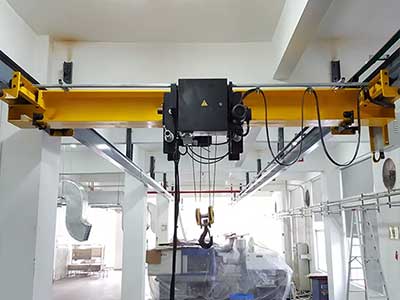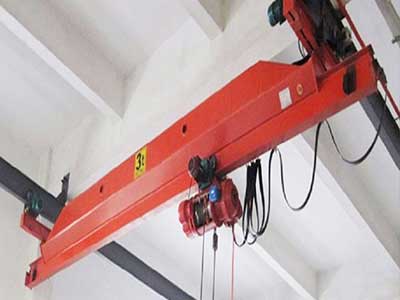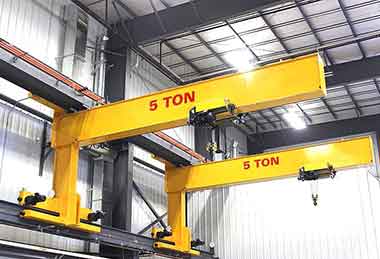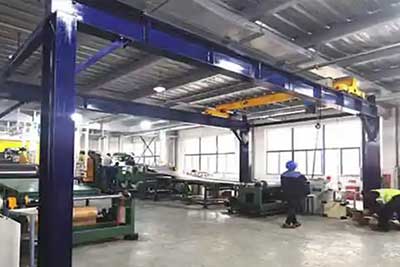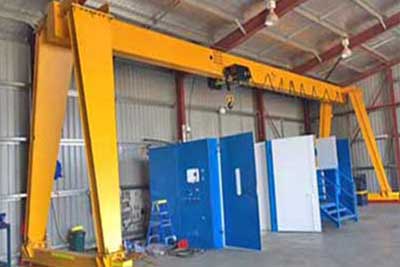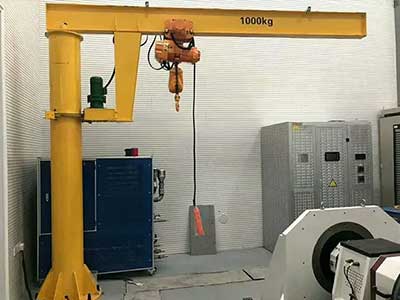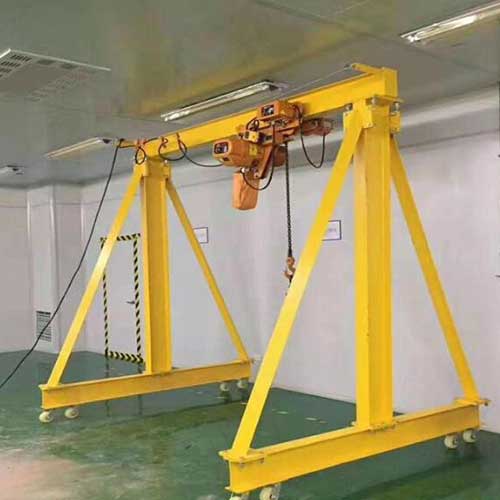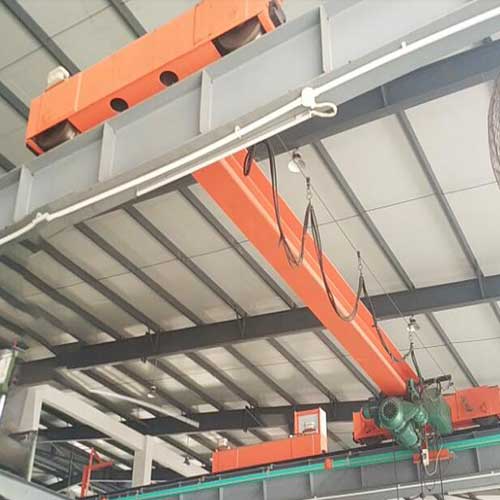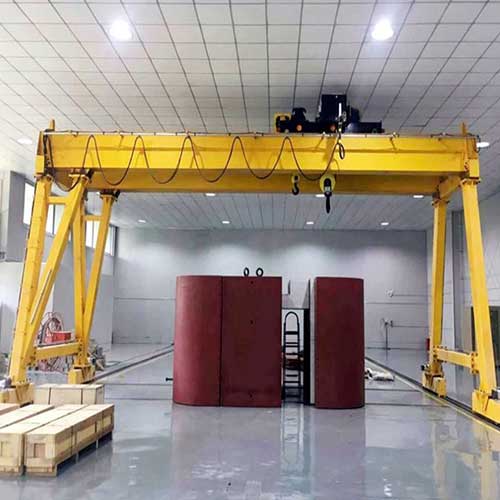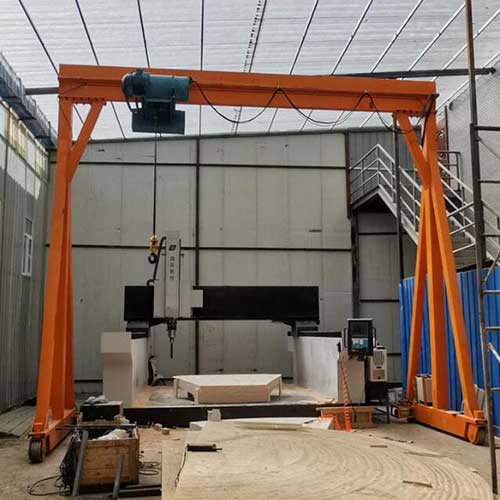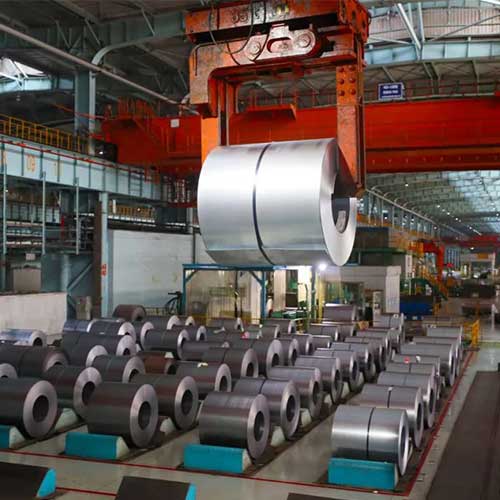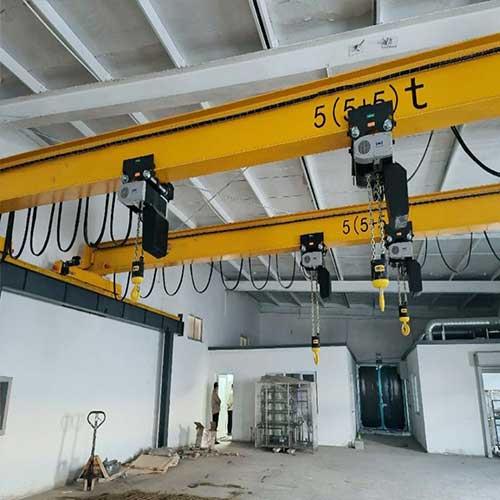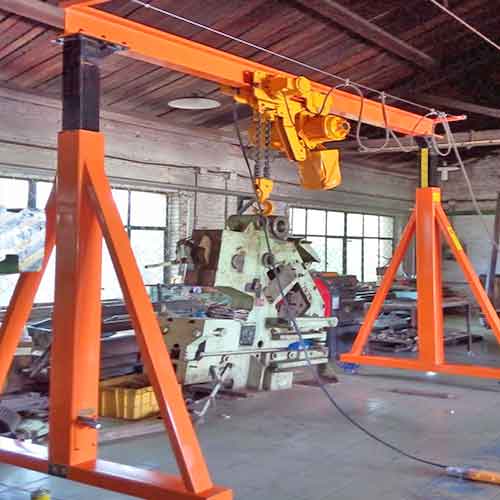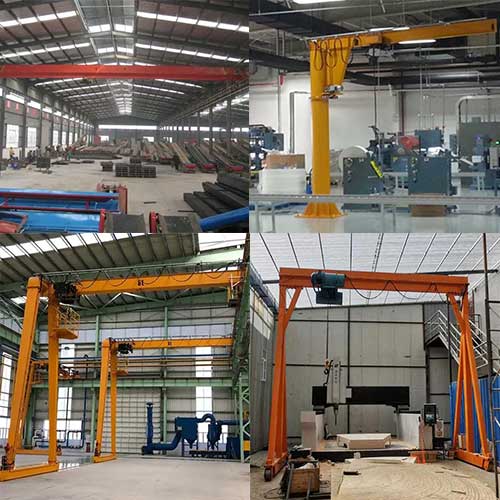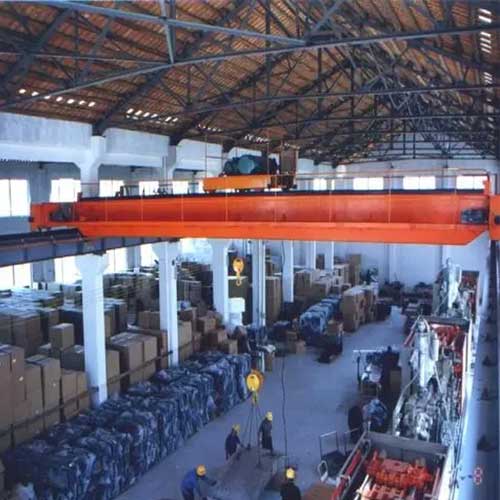Your Trusted Indoor Crane Manufacturer & Supplier
Indoor Crane: Types of Indoor Crane Systems, Get Right Crane Type
Indoor Crane Systems, i.e. Overhead, Gantry & Jib Crane, Ceiling, Wall & Floor Mounted Crane
Let's step into the fascinating world of indoor cranes, your trusty companions for heavy lifting within the cozy confines of your workplace. Indoor cranes may not always steal the spotlight, but they're the true workhorses behind efficient material handling in factories, warehouses, and production facilities.
A Quick Look at Indoor Cranes
Indoor cranes are specially designed lifting machines, tailor-made for indoor use. Unlike their outdoor cousins, indoor cranes are experts at navigating tight spaces, making every inch of your facility count.
These versatile helpers come in various shapes and sizes, each with its own unique set of skills. From the robust overhead cranes, capable of hoisting substantial loads, to the nimble wall-mounted jib cranes, perfect for those precise maneuvers, indoor cranes offer a wide array of options to cater to your specific needs.
Main Types of Indoor Cranes
Indoor cranes can be categorized based on various features, mounting types, and applications. Here are the main types of indoor cranes based on these factors:
Based on crane structures
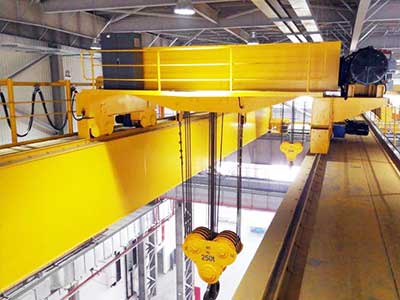
Overhead cranes are one of the most common types of indoor cranes. They are suspended from the ceiling or roof structure of a building.These cranes consist of a horizontal bridge beam that moves along a runway system. A hoist or trolley is attached to the bridge for lifting and moving loads.Overhead cranes are used in manufacturing plants, warehouses, and other industrial settings for tasks like material handling and assembly.
- Features: Suspended from the ceiling, horizontal bridge beam, hoist or trolley for lifting.
- Common Features: High lifting capacity, can cover a wide area, suitable for heavy-duty applications.
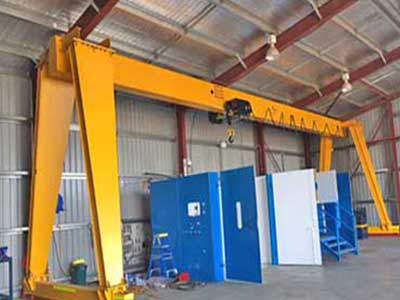
Gantry cranes are similar to overhead cranes but are supported by legs that run on the floor, rather than being suspended from the ceiling.This design provides more flexibility in terms of the crane's positioning and is often used in workshops and smaller indoor spaces.Gantry cranes are suitable for lifting heavy machinery, containers, and other large loads.
- Features: Supported by legs on the floor, horizontal bridge, hoist or trolley.
- Common Features: Versatile, can be moved to different locations, ideal for workshops and smaller indoor spaces.
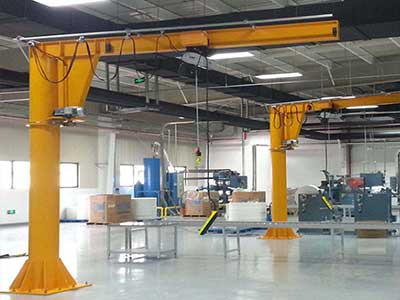
Jib cranes have a vertical mast with a horizontal boom or jib.They are ideal for lifting and maneuvering loads in a limited workspace.Jib cranes can be wall-mounted or floor-mounted and are commonly used for tasks like loading/unloading materials from machines.
- Features: Vertical mast with a horizontal boom or jib, often wall or floor-mounted.
- Common Features: Limited lifting range but excellent for localized lifting and positioning.
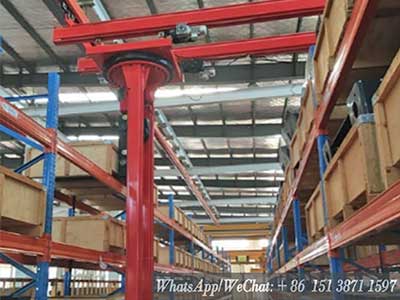
Stacker Crane
Stacker cranes are typically used in automated warehousing systems.They are designed to retrieve and store goods on high shelves or racks within a warehouse.Stacker cranes are highly efficient and can operate in narrow aisles.
- Features: Automated system for retrieving and storing goods on high shelves or racks.
- Common Features: Used in automated warehousing systems, high efficiency, narrow aisle operation.
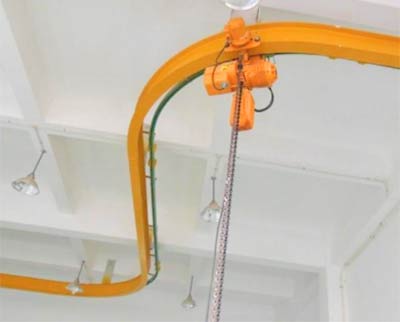
Monorail cranes consist of a single rail or track along which a hoist or trolley moves.They are used for linear material handling tasks, such as moving items along a production line or transporting materials within a fixed path.
- Features: Operates on a single rail or track, hoist or trolley for linear material handling.
- Common Features: Ideal for moving items along a fixed path, commonly used in assembly lines.
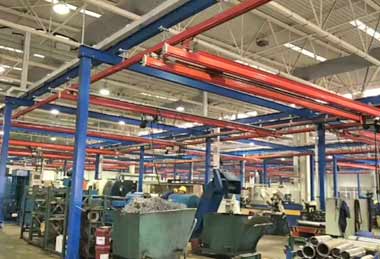
Workstation cranes are smaller, more portable cranes designed for specific workstations or assembly areas within a facility.They are often used for tasks like moving parts from one workstation to another.
- Features: Small, portable crane designed for specific workstations or assembly areas.
- Common Features: Provides localized lifting and maneuvering capabilities.
The choice of an indoor crane depends on the specific requirements of the indoor space, the type of work to be performed, the lifting capacity needed, and other factors. Each type of indoor crane has its advantages and limitations, and the selection should be based on the particular application and workspace constraints.
The Significance of Smooth Material Handling
Efficient material handling is the beating heart of manufacturing and warehousing. It's the graceful choreography of raw materials arriving at the right spot, components neatly aligning for assembly, and finished products gracefully exiting for shipping. It's about keeping operations swift, seamless, and secure.
Indoor cranes play a starring role in ensuring this choreography remains flawless. By effortlessly lifting, shifting, and placing loads, these cranes boost productivity, cut down on labor-intensive tasks, and create a safer work environment. The result? Enhanced efficiency, cost savings, and a competitive edge in today's fast-paced markets.
But indoor cranes are more than just practical tools. They embody innovation, prioritize safety, and adapt to your unique needs. They're about selecting the right crane for the right job, streamlining workflows, and taking your business to new heights.
In the coming sections, we'll delve deeper into the captivating world of indoor cranes. We'll explore their various types, uncover their features and advantages, reveal their diverse applications across industries, and address the queries and considerations of indoor crane users and prospective buyers. So, get ready to embark on a journey through the indoor crane universe—a journey that could redefine how you handle materials in your facility.
Indoor cranes are specialized lifting equipment designed for use in indoor environments, such as manufacturing facilities, warehouses, workshops, and other indoor spaces. These cranes are essential for moving heavy loads, machinery, and materials within confined spaces where traditional outdoor cranes cannot operate. There are several main types of indoor cranes, each with its own unique characteristics and applications.
Based on Mounting Types:
- a. Ceiling-Mounted Crane: - Mounted on the ceiling structure, commonly used for overhead cranes and some bridge cranes.
- b. Wall-Mounted Crane: - Attached to a wall, commonly used for jib cranes and some monorail cranes.
- c. Floor-Mounted Crane: - Supported by legs on the floor, suitable for gantry cranes and some jib cranes.
a. Ceiling-Mounted Crane:
Features:
- Mounted on the ceiling structure, which maximizes floor space in the facility.
- Typically used for overhead cranes and some bridge cranes.
- Utilizes a horizontal bridge beam that moves along overhead runways.
- Often equipped with a hoist or trolley for lifting and moving heavy loads.
Benefits:
- Maximizes floor space: Ceiling-mounted cranes free up valuable floor space in the facility, allowing for more efficient use of the workspace.
- Versatile movement: They provide a wide range of movement and coverage within the facility, making them suitable for various applications.
- Heavy lifting capacity: Ceiling-mounted cranes are capable of lifting heavy loads, making them ideal for manufacturing and material handling.
Applications:
- Manufacturing: Used for lifting and moving heavy machinery, equipment, and materials during the production process.
- Warehousing: Effective for loading and unloading goods and materials from storage racks or containers.
- Assembly Lines: Assist in the assembly of products by precisely positioning components and materials.
- Maintenance: Useful for lifting and positioning heavy equipment or machinery for maintenance and repair work.
Features:
- Attached to a wall or vertical support structure.
- Commonly used for jib cranes and some monorail cranes.
- Utilizes a vertical mast with a horizontal boom or jib.
Benefits:
- Space-saving: Wall-mounted cranes save floor space and are ideal for applications where floor space is limited.
- Precise localized movement: Jib cranes provide precise control and positioning of loads in a specific area.
- Versatility: They are versatile and can be installed at different heights and angles to suit various tasks.
Applications:
- Workstations: Used for lifting and positioning materials or components at specific workstations in a facility.
- Machine Loading/Unloading: Effective for loading and unloading materials into machines or equipment.
- Assembly: Facilitate assembly processes by positioning components accurately.
- Tool Handling: Assist in the handling of heavy tools or dies in manufacturing.
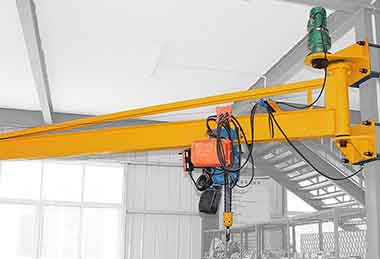
Wall mounted jib crane
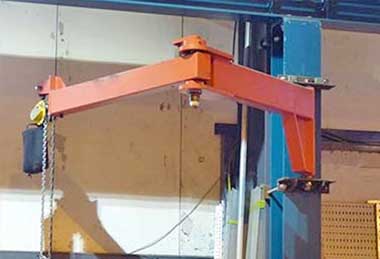
Wall mounted articulating jib crane - indoor jib crane system
Features:
- Supported by legs or a framework on the floor.
- Suitable for gantry cranes and some jib cranes.
- Offers stability and load-bearing capacity.
Benefits:
- Mobility: Gantry cranes can be moved to different locations within a facility, providing flexibility in material handling.
- Heavy-duty: Floor-mounted cranes have high load-bearing capacity and are suitable for heavy lifting.
- Versatility: They can be used indoors or outdoors, depending on the design.
Applications:
- Manufacturing: Used for moving heavy materials, machinery, and equipment within a manufacturing facility.
- Construction: Gantry cranes are employed in construction sites for lifting and positioning heavy building components.
- Shipping and Warehousing: Used for loading and unloading heavy goods from trucks and containers.
- Maintenance: Assist in lifting and positioning equipment or machinery during maintenance and repair tasks.
The choice of the type of indoor crane depends on the specific requirements of the application, available space, load capacity needed, and the desired level of precision in load positioning. Each type of crane offers distinct advantages in terms of space utilization and functionality.
Based on Applications:
These are the main types of indoor cranes based on their applications, along with their features, benefits, and typical use cases:
- a. Material Handling Crane: - Designed primarily for the movement of raw materials, components, and finished products within a facility. Includes overhead, gantry, and bridge cranes.
- b. Warehousing Crane: - Specialized for the storage and retrieval of goods in warehouses, including stacker cranes in automated storage and retrieval systems (AS/RS).
- c. Manufacturing Crane: - Used in manufacturing processes to assemble, move, or position heavy machinery and products. Includes overhead and bridge cranes.
- d. Assembly Line Crane: - Designed for repetitive tasks in assembly lines, including monorail and workstation cranes.
- e. Maintenance Crane: - Used for maintenance and repair tasks within a facility, often jib cranes for lifting heavy equipment or machinery parts.
These categories help classify indoor cranes based on their specific features, mounting configurations, and intended applications. The choice of an indoor crane should consider these factors to ensure it meets the requirements of the particular workspace and tasks to be performed.

Features:
- Designed for efficient movement of materials, components, and products within a facility.
- Capable of handling a wide range of loads and materials.
- Can be overhead, gantry, or bridge cranes, depending on the facility's needs.
Benefits:
- Streamlined Material Flow: Material handling cranes enhance productivity by facilitating the smooth flow of materials from one location to another.
- Versatile Load Capacity: These cranes can handle various load sizes and types, making them suitable for diverse applications.
- Maximizes Space: Overhead and gantry cranes, in particular, maximize floor space utilization.
Typical Use Cases:
- Factories and Manufacturing Plants: For moving raw materials, work-in-progress components, and finished products.
- Warehouses: For efficient storage and retrieval of goods.
- Distribution Centers: For loading and unloading trucks and containers.
- Heavy Industry: In sectors like steel manufacturing, where handling heavy materials is common.
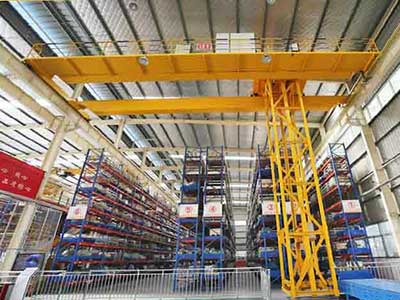
b. Warehousing Crane (Including Stacker Cranes):
Features:
- Specialized for the storage and retrieval of goods in warehouses and distribution centers.
- Stacker cranes are a common type used in automated storage and retrieval systems (AS/RS).
- Can operate in high-density storage environments.
Benefits:
- Maximizes Vertical Storage: Warehousing cranes efficiently utilize vertical storage space by reaching high shelves.
- Automated Operations: Stacker cranes in AS/RS systems automate storage and retrieval processes, reducing labor requirements.
- Enhanced Inventory Management: These cranes improve inventory accuracy and accessibility.
Typical Use Cases:
- Large Warehouses: For storing and retrieving palletized goods.
- E-commerce Fulfillment Centers: Utilized for efficient order picking and packing.
- Cold Storage Facilities: Ensures efficient access to frozen or refrigerated goods.

Features:
- Used in manufacturing processes to assemble, move, or position heavy machinery and products.
- Includes overhead and bridge cranes designed for heavy-duty applications.
- Often integrated into production lines.
Benefits:
- Precision Handling: Manufacturing cranes provide precise control, critical for assembly and positioning tasks.
- High Load Capacity: Suitable for lifting and moving heavy machinery components.
- Workflow Integration: Integration into production lines streamlines manufacturing processes.
Typical Use Cases:
- Automotive Manufacturing: For assembling vehicles and handling heavy automotive components.
- Aerospace Industry: Used in the assembly and transportation of aircraft parts.
- Heavy Machinery Production: Handling and positioning of large and heavy machinery.
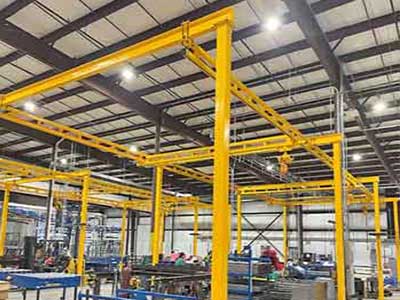
d. Assembly Line Crane:
Features:
- Designed for repetitive tasks in assembly lines.
- Includes monorail and workstation cranes.
- Offers precision and efficiency for assembly processes.
Benefits:
- Streamlined Production: These cranes facilitate efficient assembly line operations.
- Ergonomic Workstations: Workstation cranes help reduce operator fatigue and improve ergonomics.
- Versatile Configurations: Monorail cranes can be tailored to follow specific assembly line paths.
Typical Use Cases:
- Automobile Assembly: Monorail and workstation cranes assist in assembling vehicles.
- Electronics Manufacturing: Used for assembling electronic components.
- Small Parts Assembly: Ideal for precise handling of small components.
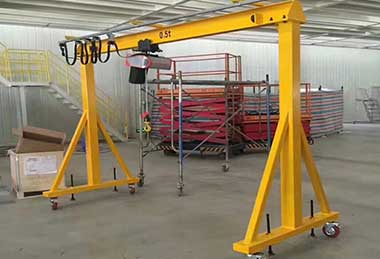
Features:
- Used for maintenance and repair tasks within a facility.
- Often jib cranes for lifting heavy equipment or machinery parts.
- Equipped with features for precise positioning.
Benefits:
- Accessibility: Maintenance cranes provide access to machinery and equipment for servicing and repairs.
- Safety: Precise control ensures safe lifting and positioning of heavy components.
- Reduced Downtime: Quick access to machinery minimizes downtime during maintenance.
Typical Use Cases:
- Industrial Facilities: For maintaining and repairing heavy machinery, such as engines and presses.
- Construction Sites: To lift and position construction equipment and materials.
- Manufacturing Plants: For servicing production machinery and molds.
These types of indoor cranes are tailored to specific applications and provide essential benefits that improve efficiency, safety, and productivity within various industries and settings. The choice of the crane type depends on the unique requirements of each application.
Based on working environment : Low headroom space constraint, explosion proof , clean room
In indoor workshops or facilities with explosion-proof requirements, low headroom, and limited space, it's crucial to select specialized indoor cranes that meet safety and space constraints. Here are typical indoor cranes used in such environments:
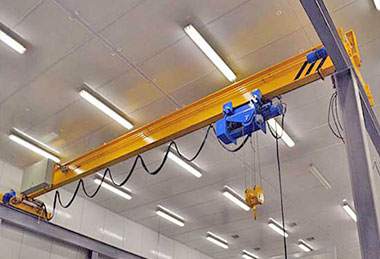
- Characteristics: Explosion-proof cranes are designed to operate in environments where flammable gases, vapors, or dust particles may be present. They are equipped with safety features to prevent sparking and explosions.
- Conditions: Hazardous environments with potential explosive atmospheres.
- Requirements: Safety is paramount, so cranes must be explosion-proof and meet stringent safety standards.
- Crane Types: Explosion-proof overhead cranes (single or double girder) or explosion-proof jib cranes.
- Features: Specialized electrical components and enclosures to prevent sparking.
- Explosion-proof hoists and controls.
- Benefits: Enhanced safety in potentially explosive atmospheres.
- Functions: Handling materials in hazardous indoor environments, such as chemical plants or refineries.
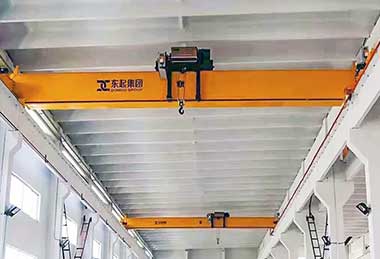
- Characteristics: Low headroom cranes are designed for indoor spaces with limited overhead clearance. They have a compact design to maximize vertical lifting space.
- Conditions: Indoor environments with restricted vertical space.
- Requirements: Efficient material handling without interference from low ceilings.
- Crane Types: Low headroom single girder bridge cranes.
- Features: Compact design with reduced headroom. - Maximum vertical lift within limited space.
- Benefits: Efficient material handling in facilities with low ceilings.
- Functions: Handling materials where traditional cranes would not fit due to limited headroom.
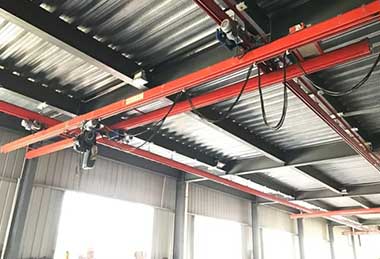
- Characteristics: Limited space cranes are designed for indoor facilities where available space is at a premium. They are compact and often have a smaller footprint.
- Conditions: Indoor environments with limited floor space.
- Requirements: Efficient material handling without taking up excessive floor area.
- Crane Types: Wall-mounted jib cranes, compact gantry cranes.
- Features: Space-saving design with a smaller footprint.
- Installation on walls or compact gantry structures.
- Benefits: Maximizes the use of available space.
- Functions: Handling materials efficiently in tight indoor spaces, such as workshops with cluttered floors.
These specialized indoor cranes are essential for addressing specific challenges in indoor workshops or facilities with explosion-proof requirements, low headroom, and limited space. They ensure safe and efficient material handling while meeting the unique demands of each environment.
In dust-free workshops, labs, and other clean environments, it's essential to maintain cleanliness and prevent contamination. Therefore, specialized cranes designed for such environments are used. Here are the typical types of cranes and their applications in these clean settings:
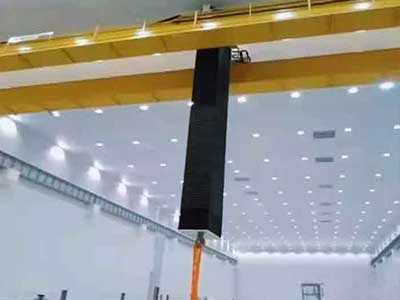
- Characteristics: Cleanroom cranes are designed to operate within controlled environments such as semiconductor cleanrooms, pharmaceutical labs, or biotech facilities. They have features to prevent particle generation and contamination.
- Conditions: Highly controlled cleanroom environments with strict cleanliness and contamination control requirements.
- Requirements: Minimal particle generation, non-shedding materials, and adherence to cleanroom protocols.
- Crane Types: Cleanroom overhead cranes (single or double girder), cleanroom jib cranes.
- Features: Stainless steel or non-shedding materials.
- Sealed components to prevent particle emissions.
- Benefits: Ensures cleanliness and compliance with cleanroom standards.
- Applications: Handling sensitive equipment, materials, or products within cleanrooms, labs, and pharmaceutical production facilities.
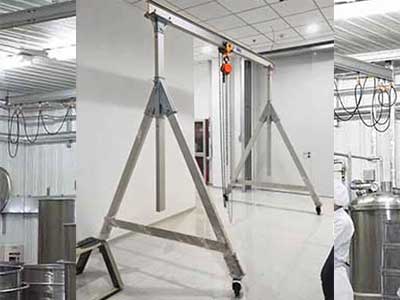
Aluminum gantry crane for sterile environment crane
- Characteristics: These cranes are used in environments where sterility is crucial, such as surgical suites, laboratories, and pharmaceutical cleanrooms. They prevent contamination.
- Conditions: Sterile environments where maintaining aseptic conditions is paramount.
- Requirements: Sterility, easy cleaning, and materials that do not shed particles.
- Crane Types: Sterile environment overhead cranes (single or double girder), sterile environment jib cranes.
- Features: Materials and coatings that are easy to clean and sterilize.
- Smooth surfaces and sealed components to prevent contamination.
- Benefits: Maintains sterility and prevents contamination of sensitive products or processes.
- Applications: Handling sterile equipment, lab samples, or medical instruments in hospitals, surgical suites, and laboratories.
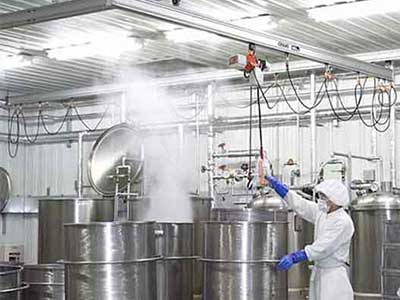
Food and Beverage Industry Cranes:
- Characteristics: - These cranes are used in food and beverage processing facilities, where cleanliness and hygiene are essential to meet food safety standards.
- Conditions: - Environments where food and beverages are processed or packaged.
- Requirements: - Food-grade materials, easy cleaning, and corrosion resistance.
- Crane Types: Food-grade overhead cranes (single or double girder), food-grade jib cranes.
- Features: Stainless steel or food-grade coatings.
- Smooth surfaces to prevent bacterial growth.
- Benefits: - Ensures food safety and hygiene compliance.
- Applications: - Handling food products, ingredients, or packaging materials in food and beverage processing facilities.
These specialized cranes are designed to meet stringent cleanliness and contamination control requirements in various clean and sterile environments. They play a crucial role in maintaining the integrity of sensitive processes and products in industries where cleanliness is paramount.
Typical Applications of Indoor Crane Systems for Different Industrial Sectors
Manufacturing Facilities:
- Characteristics: - Manufacturing environments can range from heavy machinery assembly lines to cleanrooms for electronics manufacturing. They may involve the presence of various equipment, materials, and processes.
- Conditions: - Indoor manufacturing spaces vary in temperature, cleanliness, and layout.
- Requirements: - Efficient material handling, precision in positioning, and often the need for clean and controlled environments.
- Crane Types: Single Girder Bridge Cranes, Double Girder Bridge Cranes.
- Features: - Precision positioning for assembly. - High lifting capacities. - Customizable to fit the manufacturing process.
- Benefits: - Enhanced manufacturing efficiency. - Reduced labor costs.
- Functions: - Moving raw materials, components, and finished products within the facility, precise positioning for assembly processes.
Warehouses and Distribution Centers:
- Characteristics: - Warehouses are typically large indoor spaces for storing and distributing goods. They can be high-ceilinged structures with racks or shelves for storage.
- Conditions: - Warehouses can be dimly lit and may have varying temperatures depending on the stored goods.
- Requirements: - Fast and efficient loading/unloading, organized storage, and space optimization.
- Crane Types: Single Girder Bridge Cranes, Double Girder Bridge Cranes, Gantry Cranes.
- Features: - Efficient loading/unloading. - Space optimization. - Versatile material handling capabilities.
- Benefits: - Streamlined warehousing operations. - Reduced manual handling.
- Functions: - Goods handling, organized storage, and efficient loading/unloading of goods.
Aerospace Hangars:
- Characteristics: - Aerospace hangars are large indoor facilities used for aircraft assembly, maintenance, and storage. They often have high ceilings and wide-open spaces.
- Conditions: - Hangars are typically well-lit and maintained, with controlled environmental conditions.
- Requirements: - Handling large and heavy aerospace components, precision in positioning aircraft, and ensuring safety during maintenance tasks.
- Crane Types: Double Girder Bridge Cranes.
- Features: - High lifting capacities for large aerospace components. - Precise positioning for assembly and maintenance.
- Benefits: - Ensures safety and precision in aerospace manufacturing.
- Functions: - Handling and positioning of aircraft components, maintenance, and repairs within hangars.
Automotive Plants:
- Characteristics: - Automotive manufacturing plants consist of indoor assembly lines with various workstations for vehicle production.
- Conditions: - Manufacturing plants have controlled environments with consistent lighting.
- Requirements: - Efficient material handling, precise positioning of vehicle parts, and maintaining production flow.
- Crane Types: Single Girder Bridge Cranes, Double Girder Bridge Cranes.
- Features: - Efficient material handling for vehicle assembly. - Versatile for positioning vehicle parts.
- Benefits: - Accelerated production processes. - Improved quality control.
- Functions: - Vehicle assembly lines, parts handling, and storage.
Cold Storage Facilities:
- Characteristics: Cold storage facilities are designed for the refrigerated or frozen storage of perishable goods.
- Conditions: These environments maintain low temperatures, often below freezing.
- Requirements: Handling frozen food products, efficient pallet movement, and ensuring temperature control.
- Crane Types: Single Girder Bridge Cranes.
- Features: Suitable for temperature-controlled environments. - Efficient pallet handling.
- Benefits: Maintains product quality in cold storage.
- Functions: Handling frozen food products, pallet movement in refrigerated storage.
Indoor Construction Sites:
- Characteristics: Indoor construction sites may include renovations, building interiors, or projects in confined spaces.
- Conditions: Environments can be dusty, and space may be limited.
- Requirements: Precision in positioning heavy construction materials and equipment, safety in confined spaces.
- Crane Types: Gantry Cranes, Portable Gantry Cranes.
- Features: Precise positioning for construction materials. - Space-saving designs.
- Benefits: Efficient indoor construction projects.
- Improved safety during material handling.
- Functions: Heavy material positioning, equipment installation.
Cleanrooms (e.g., Electronics Manufacturing):
- Characteristics: Cleanrooms are highly controlled environments with strict cleanliness and contamination control measures.
- Conditions: Extremely clean environments with regulated temperature and humidity.
- Requirements: Delicate material handling, precision positioning, and maintaining clean conditions.
- Crane Types: Single Girder Bridge Cranes.
- Features: Delicate handling of microelectronics components. - Precision for assembly tasks.
- Benefits: Protects sensitive electronic components.
- Functions: Microelectronics assembly, material transport within cleanrooms.
Textile Mills:
- Characteristics: Textile mills involve the processing of fabrics and textiles.
- Conditions: Environments can be noisy with textile machinery.
- Requirements: Efficient handling of textile rolls and materials, maintaining production flow.
- Crane Types: Single Girder Bridge Cranes.
- Features: Efficient handling of textile rolls. - Efficient material transport.
- Benefits: Reduces manual labor in textile handling.
- Functions: Transporting and positioning textile rolls in textile mills.
This format provides a detailed overview of each indoor environment, its crane requirements, and the specific crane types and features commonly used in those settings.
